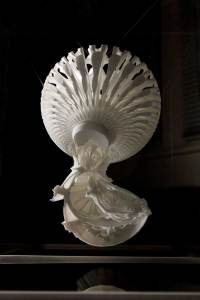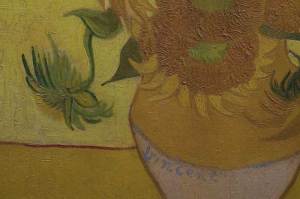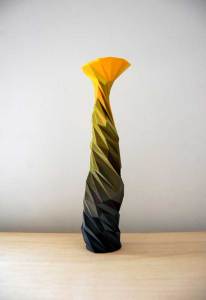Translating computer data into real objects. It sounds like a nightmarish combination of algebra, spreadsheets, and the chemically implausible. But this is the premise of 3D printing, one of the most important technological developments of recent years, that is becoming increasingly available – at a sum – to the mass market, and perhaps also to artists. The Science Museum’s exhibition ‘3D: printing the future’ spotlights the technology’s potential within industries such as transportation and medicine, as well as showcasing artists such as Tobias Klein, whose work straddles the realms of sculpture, architecture and the digital world.

Inversive Embodiment, Tobias Klein, courtesy Ute Klein
The creative possibilities offered by this ‘digital world’ are seemingly endless. 3D printing is one of its relatively nascent hatchlings, allowing artists to fashion objects and ideas otherwise impossible to craft by hand, from sculptural miniatures to practical home wares. Already producing works in a variety of materials (sandstone, plastic, gold), its versatility suggests 3D print art might prove more than a science-based fad. This versatility is reflected in the many open pathways for future collectors, who might pursue original designs or scrupulous reproductions of celebrated artworks.
Klein is one of the exhibitors at the 3D Printshow, a global fair working its way across continents from London, last weekend, to Paris this weekend, and New York in February. The show’s artists are testament to the myriad ways of investing in a burgeoning medium: Joshua Harker’s palm-sized skulls and intricately detailed, sometimes mechanical, creations are available from his online shop; some artists have works available through independent galleries; Isaie Bloch is among those who work to commission (in his case, encompassing sandstone busts and 18-carat gold cutlery).

Masterpieces by Vincent van Gogh will be replicated using the new technology
Elsewhere, 3D printing shatters a copy-cat’s wildest dreams with pinpoint precision. In July, Fujifilm introduced the world to reliefography – a reproduction technique that has taken seven years to perfect. Following a 3D scan of a painting, reliefography makes it possible to produce an exact replica of the original, right down to the labels and stamps on the frame.
Only three pieces can be made per day using the technology, but Fujifilm has tested the market’s murky waters with an exclusive three-year partnership with the Van Gogh Museum, creating a limited edition of 260 copies per painting. Each piece is checked and approved by the museum’s curators, at €25,000 each.

Digital Natives (2012), Matthew Plummer-Fernandez, courtesy the artist
Many younger designers are opting to open-source their work. Matthew Plummer-Fernandez both creates physical prints and hosts 3D print files online that can be downloaded for free, allowing individuals to modify the design and render it for themselves using a PLA or similar printer. ‘I’m connecting to an audience that gives and takes freely,’ he explains, ‘it’s about being part of an online community that wants ideas and culture to progress without restrictions and financial incentives.’
Fernandez sees 3D printing as able to transform ‘transient digital art into a material object that has the permanence required for a long-term collection.’ And, he believes, it has as much potential as any other medium: ‘great artists can make the most unlikely materials and processes become great art.’
‘3D: printing the future’ is at the Science Museum, London until 15 June 2014.

Printing Press
Inversive Embodiment, Tobias Klein, courtesy Ute Klein
Share
Translating computer data into real objects. It sounds like a nightmarish combination of algebra, spreadsheets, and the chemically implausible. But this is the premise of 3D printing, one of the most important technological developments of recent years, that is becoming increasingly available – at a sum – to the mass market, and perhaps also to artists. The Science Museum’s exhibition ‘3D: printing the future’ spotlights the technology’s potential within industries such as transportation and medicine, as well as showcasing artists such as Tobias Klein, whose work straddles the realms of sculpture, architecture and the digital world.
Inversive Embodiment, Tobias Klein, courtesy Ute Klein
The creative possibilities offered by this ‘digital world’ are seemingly endless. 3D printing is one of its relatively nascent hatchlings, allowing artists to fashion objects and ideas otherwise impossible to craft by hand, from sculptural miniatures to practical home wares. Already producing works in a variety of materials (sandstone, plastic, gold), its versatility suggests 3D print art might prove more than a science-based fad. This versatility is reflected in the many open pathways for future collectors, who might pursue original designs or scrupulous reproductions of celebrated artworks.
Klein is one of the exhibitors at the 3D Printshow, a global fair working its way across continents from London, last weekend, to Paris this weekend, and New York in February. The show’s artists are testament to the myriad ways of investing in a burgeoning medium: Joshua Harker’s palm-sized skulls and intricately detailed, sometimes mechanical, creations are available from his online shop; some artists have works available through independent galleries; Isaie Bloch is among those who work to commission (in his case, encompassing sandstone busts and 18-carat gold cutlery).
Masterpieces by Vincent van Gogh will be replicated using the new technology
Elsewhere, 3D printing shatters a copy-cat’s wildest dreams with pinpoint precision. In July, Fujifilm introduced the world to reliefography – a reproduction technique that has taken seven years to perfect. Following a 3D scan of a painting, reliefography makes it possible to produce an exact replica of the original, right down to the labels and stamps on the frame.
Only three pieces can be made per day using the technology, but Fujifilm has tested the market’s murky waters with an exclusive three-year partnership with the Van Gogh Museum, creating a limited edition of 260 copies per painting. Each piece is checked and approved by the museum’s curators, at €25,000 each.
Digital Natives (2012), Matthew Plummer-Fernandez, courtesy the artist
Many younger designers are opting to open-source their work. Matthew Plummer-Fernandez both creates physical prints and hosts 3D print files online that can be downloaded for free, allowing individuals to modify the design and render it for themselves using a PLA or similar printer. ‘I’m connecting to an audience that gives and takes freely,’ he explains, ‘it’s about being part of an online community that wants ideas and culture to progress without restrictions and financial incentives.’
Fernandez sees 3D printing as able to transform ‘transient digital art into a material object that has the permanence required for a long-term collection.’ And, he believes, it has as much potential as any other medium: ‘great artists can make the most unlikely materials and processes become great art.’
‘3D: printing the future’ is at the Science Museum, London until 15 June 2014.
Unlimited access from just $16 every 3 months
Subscribe to get unlimited and exclusive access to the top art stories, interviews and exhibition reviews.
Share
Recommended for you
A Matter of Taste
The Ecole des Beaux-arts – now controversially sponsored by Ralph Lauren – is at the centre of debates about the relationship between art and luxury in France
Lost Gold
The exhibits at ‘Beyond El Dorado’ are compelling not only for the myths associated with them, but for their idiosyncratic human appeal
Spencer’s Tour
Stanley Spencer’s paintings from the Sandham Memorial Chapel – currently touring the UK – are among the most important artistic responses to the First World War